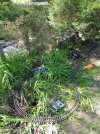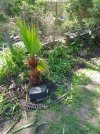What is wrong with just melting solder into the joint? And what is the best solder to use. I have a small bottle of liquid solder. I do not need a iron to use it. I use for my house plumbing. It has a copper look to it. As well there is a blast that I can put over my clay earth. Chicken something it is called.
OK.. Where to start:
If you were to heat a stick of solder, and drip it into the joints, it would instantly cool (and not 'stick') to the rail-ends. - You need to get the rail hot enough, for the flux to do its job, and the solder to 'take' (stick/bond) to the rail.
By 'liquid solder' I am assuming you mean a grey-paste? - Solder powder and flux. You will need to clean the rail-ends (and the joiners) before trying to solder.
This is all the work necessary for a good oudh-fit joint, Barring a little 'copper-grease' and squeezing-up the joiners a little..
Your track will also move over time. - The ground will move, it will expand/contract with temperature. If there are no joints, where it can move, it will buckle in some way, and your soldered joints will break.
Also, if you have soldered the actual rails together, you will find it very difficult to move the track around.
Chicken Grit is OK for ballast, but check it is not crushed she'll, as this will slowly dissolve in the rain.
If you can get some weed membrane, you can cut it into strips, and put it down before you ballast.. The ballast will not disappear into the soil so quickly.. You can lift it, and wash the ballast, for when you make changes.
Plastic sheet is not good, as it holds water.
PhilP





